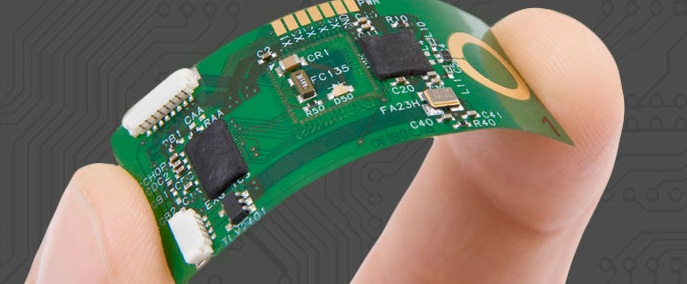Flex PCBs and the Internet of Things (IOT)
The term Internet of Things (IoT) is an umbrella term that covers a broad range of technologies, applications, and use cases enabled by connecting objects and devices via an Internet Protocol (IP) address. Underneath this umbrella of IoT technology fall a variety of terms such as the Internet of Everything, the IoT for home, the Internet of Medical Things, Industry 4.0, the Internet of Services, the IoT for security and defense, and the Industrial Internet of Things (IIoT). IoT itself comprises a huge variety of diverse, technology stacks, such as the wireless IoT network and communication protocols, standards, and much more.

The above trends not only enabled the IoT technology, but also drove up the demand for IoT board manufacturing, especially the Flex and HDI PCBs. Today, these types of IoT PCBs play a pivotal role in the advancement of IoT technology.
Opportunities for Flex PCBs in the IoT
With the increasing spread of IoT technology, expect tens of billions of new devices to connect to the IP networks. A major number of these IoT devices will need PCBs that fit into very tight spaces while working to high specifications. According to research by Gartner, the number of IoT devices connecting to the Internet will cross 25 billion by the year 2020.
This presents a huge opportunity for OEMs making IoT devices such as wearables, especially as these put unparalleled demands on PCBs. For instance, the circuit board inside a device tracking fitness has to withstand different dynamic stresses such as frequent flexing. Only flexible and HDI PCBs are capable of handling such stress without failure.
The Flexible Approach
While the convergence of the mechanical and electrical design gives us devices with eye-catching curves and contours, it actually leaves the irregularly shaped structures with little space to run wire bundles behind them for incorporating a sensor. However, a flex circuit has no problem in fitting perfectly within the limited space, as it can conform to the curved surface.
Designers commonly use flexible circuits in confined spaces and fold it around corners to form a tighter packaging. Most places where traditional solutions will not meet design constraints, flexible PCBs are the alternative path forward. For IoT devices such as wearable electronics in a shirt, it is easier to sew in flex circuits rather than run a bunch of wires along with their sensors, which can make the shirt a bulky item.
Also Read; What You Should Know About Flex and Rigid Flex Circuit Board Manufacturing
IoT for Health
Designers and OEMs consider flexible technologies and miniaturization as one of the seven technology building blocks necessary for creating wearable electronic products. Wearable electronic products can be worn within the body, on the body, or close to the body. In all cases, flexible interconnect technology along with miniature components are now essential to the wearable electronics market.
The form, fit, cost, and function of the IoT devices drive the choice between a printed circuit and a printed electronics technology. By combining the material and design, designers can select from among flexible, rigid, and stretchable PCB solutions. Printed circuit technologies primarily consist of rigid, flexible, and rigid-flex circuits. They are fabricated with conventional methods such as etching copper sheets and laminations on dielectric materials. More recently, every-layer interconnect connection along with high-density interconnect PCBs are providing the higher functionality that advanced smart connected wearable devices demand.
Other advancements in IoT for health involve printed electronics technology. This uses printing methods such as ink-jet printing, gravure, and screen-printing for creating interconnects on different substrates. The electrical circuit pattern deposited onto the substrate is typically made of materials such as conductive inks and pastes. Use of printed electronics is bringing down the expenses incurred in processing and materials, but the complexity in design and performance is higher as compared to that involved with flexible circuits.
Custom PCB Design
IoT board manufacturing with custom PCB manufacturing has several applications as flexible circuit technologies offer improved electrical performance, reduced weight and volume, improved interconnect reliability, and larger design freedom. All these advantages appeal to the IoT for business, IoT for home, IoT for security and defense, and IoT for space applications. Of these, the driving application for flexible PCBs is the consumer electronics, specifically the mobile and handheld IoT devices that benefit the most from the increased functional density, enlarged user comfort, and the reduction in form factors that these technologies have to offer.
In the same way, IoT for security and defense, including IoT for space also find appealing the increase in electrical performance, reduced volume and weight, increased design freedom, and improved interconnect reliability that flexible technologies offer.
Custom PCB design helps to integrate seamlessly the flexible PCB into the IoT devices that users carry along, or wear on or inside their bodies. Acceptance depends on the electronics being comfortable and unnoticeable to the user. OEMs tend to improve the user comfort in one of two ways—extreme miniaturization of the device reducing its presence, or transforming the flat rigid circuit into a 3-dimensional conformable shape. The second approach follows the random shape of the body part onto which the IoT device is integrated.
Conclusion
Although flex PCBs are not new to the field of electronics, IoT technology is benefitting hugely from flexible concepts as creativity and engineering along with custom PCB design are helping to create miniature IoT devices with greater functionality and reliability, while offering greater wearing comfort.

